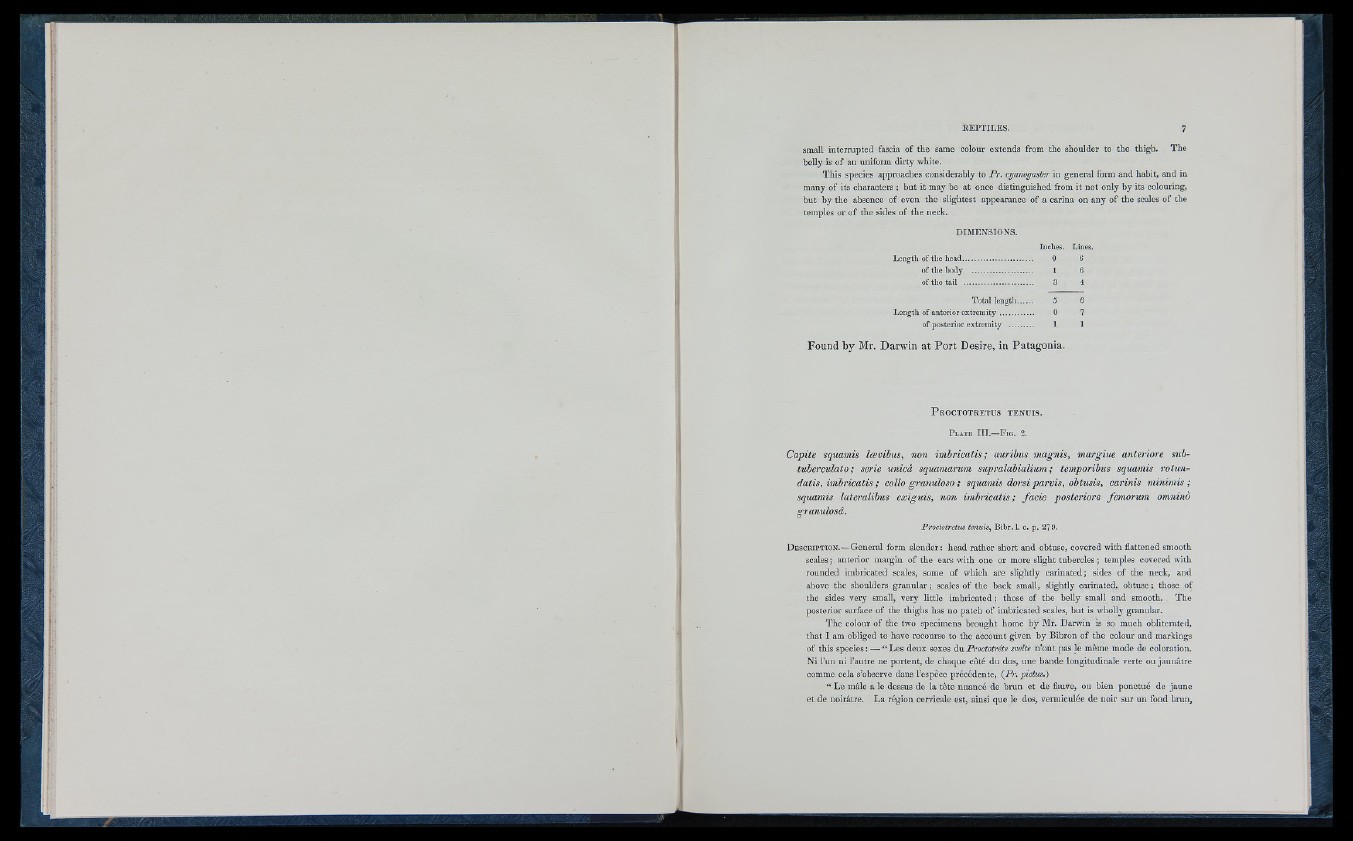
REPTILES. 7
small in te rru p te d fascia o f th e same colour ex ten d s from th e shoulder to th e thigh. T h e
belly is o f an uniform d irty white.
T h is species approaches considerably to P r . cyanogaster in g en e ral form and habit, an d in
many o f its cha rac ters ; b u t it may be a t once distinguished from it n o t only b y its colouring,
b u t by th e absence o f even th e slighte st appearance o f a ca rina on an y o f th e scales o f the
temples or o f the sides o f th e neck.
D IM E N S IO N S ,
Inches. Lines.
Length of the head.................................. 0 6
of the body 1 6
of the tail .................................. 3 4
Totallength 5 6
Length of anterior extremity................. 0 7
of posterior extremity 1 1
Found by Mr. Darwin at P o rt Desire, in Patagonia.
P r o c t o t r e t u s t e n u i s .
P late I I I .—F ig . 2.
Capite squamis lævibus, non imbricatis; auribus magnis, margine anteriore sub-
tuberculato; serie unicâ squamarum supralabialium; temporibus squamis rotundatis,
imbricatis ; collo granuloso ; squamis dorsi parvis, obtusis, carinis minimis;
squamis lateralibus exigtiis, non imbricatis; facie posteriore femorum omninò
granulosâ.
Proctotretus tenuis, Bibr. I. o. p. 279.
D e sc r ip t io n .—G e n era l form s le n d e r: h e a d ra th e r short an d obtuse, covered with flattened smooth
scales ; an te rio r margin o f th e ears with one o r more slight tuberc les ; temples covered with
rounded imbricated scales, some o f which are slightly c a rin a ted ; sides o f th e neck, and
above th e shoulders g ra n u la r ; scales o f th e back small, slightly carinated, obtuse ; those of
th e sides very small, very little imbricated ; those o f th e belly small an d smooth. T h e
posterior surface o f th e thighs has no p a tc h o f imbricated scales, b u t is wholly granula r.
T h e colour o f th e two specimens b ro u g h t home by Mr. Da rwin is so much obliterated,
th a t I am obliged to have recourse to th e ac count given by Bibron o f th e colour an d markings
o f this species : — “ L e s d eu x sexes d u Proctotréte svelte n ’o n t pas le même mode de coloration.
N i l’un n i l’au tre ne p o rten t, de chaque côté d u dos, u n e ban d e lo ngitudina le v erte ou jau n â tre
comme cela s’observe dans l’espèce p ré cédente, (P r. pictus.)
“ L e mâle a le dessus de la tê te n u an c é de b ru n e t de fauve, ou b ien p o n c tu é de jau n e
e t de noirâtre. L a région cervicale est, ainsi que le dos, vermiculée de n o ir su r u n fond brun.